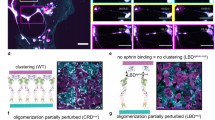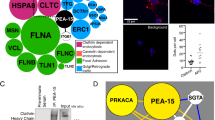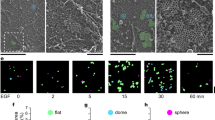Abstract
Cadherins are major cell – cell adhesion molecules in both tumor and normal tissues. Although serum levels of soluble E-cadherin have been shown to be higher in the cancer patients than in healthy volunteers, the detail mechanism regulating release of soluble E-cadherin remains to be elucidated. Here we show that the ectodomain of E-cadherin is proteolytically cleaved from some cancer cells by a membrane-bound metalloprotease to yield soluble form, and the residual membrane-tethered cleavage product is subsequently degraded by intracellular proteolytic pathway. Futhermore, we show that extracellular calcium influx, that is induced by mechanical scraping of cells or ionomycin treatment, enhances the metalloprotease-mediated E-cadherin cleavage and the subsequent degradation of the cytoplasmic domain. Immunocytochemical analysis demonstrates that the sequential proteolysis of E-cadherin triggered by the calcium influx results in translocation of β-catenin from the cell – cell contacts to cytoplasm. Our data suggest that calcium influx-induced proteolysis of E-cadherin not only disrupts the cell – cell adhesion but also activates β-catenin-mediated intracellular signaling pathway, potentially leading to alterations in motility and proliferation activity of cells.
This is a preview of subscription content, access via your institution
Access options
Subscribe to this journal
Receive 50 print issues and online access
$259.00 per year
only $5.18 per issue
Buy this article
- Purchase on Springer Link
- Instant access to full article PDF
Prices may be subject to local taxes which are calculated during checkout






Similar content being viewed by others
References
Aberle H, Butz S, Stappert J, Weissig H, Kemler R and Hoschuetzky H. . 1994 J. Cell. Sci. 107: 3655–3663.
Berridge MJ, Bootman MD and Lipp P. . 1998 Nature 395: 645–648.
Chomczynski P and Sacchi N. . 1987 Anal. Biochem. 162: 156–159.
Codony-Servat J, Albanell J, Lopez-Talavera JC, Arribas J and Baselga J. . 1999 Cancer Res. 59: 1196–1201.
Coomber BL and Gotlieb AI. . 1990 Arteriosclerosis 10: 215–222.
Damsky CH, Richa J, Solter D, Knudsen K and Buck CA. . 1983 Cell 34: 455–466.
Dethlefsen SM, Raab G, Moses MA, Adam RM, Klagsbrun M and Freeman MR. . 1998 J. Cell. Biochem. 69: 143–153.
Di Fiore PP, Pierce JH, Kraus MH, Segatto O, King CR and Aaronson SA. . 1987 Science 237: 178–182.
Felgner PL, Gadek TR, Holm M, Roman R, Chan HW, Wenz M, Northrop JP, Ringold GM and Danielsen M. . 1987 Proc. Natl. Acad. Sci. USA 84: 7413–7417.
Gofuku J, Shiozaki H, Doki Y, Inoue M, Hirao M, Fukuchi N and Monden M. . 1998 Br. J. Cancer 78: 1095–1101.
Gordon MY. . 1991 Cancer Cells 3: 127–133.
He TC, Sparks AB, Rago C, Hermeking H, Zawel L, da Costa LT, Morin PJ, Vogelstein B and Kinzler KW. . 1998 Science 281: 1509–1512.
Herren B, Levkau B, Raines EW and Ross R. . 1998 Mol. Biol. Cell 9: 1589–1601.
Hirohashi S. . 1998 Am. J. Pathol. 153: 333–339.
Hooper NM, Karran EH and Turner AJ. . 1997 Biochem. J. 321: 265–279.
Huber O, Korn R, McLaughlin J, Ohsugi M, Herrmann BG and Kemler R. . 1996 Mech. Dev. 59: 3–10.
Hulsken J, Birchmeier W and Behrens J. . 1994 J. Cell Biol. 127: 2061–2069.
Ito A, Nakajima S, Sasaguri Y, Nagase H and Mori Y. . 1995 Br. J. Cancer 71: 1039–1045.
Jeffers M, Taylor GA, Weidner KM, Omura S and Vande Woude GF. . 1997 Mol. Cell. Biol. 17: 799–808.
Katayama M, Hirai S, Kamihagi K, Nakagawa K, Yasumoto M and Kato I. . 1994 Br. J. Cancer 69: 580–585.
Lin YZ and Clinton GM. . 1991 Oncogene 6: 639–643.
Lochter A, Galosy S, Muschler J, Freedman N, Werb Z and Bissell MJ. . 1997 J. Cell Biol. 139: 1861–1872.
Lombard MA, Wallace TL, Kubicek MF, Petzold GL, Mitchell MA, Hendges SK and Wilks JW. . 1998 Cancer Res. 58: 4001–4007.
Murphy AJM, Kung AL, Swirski RA and Schimke RT. . 1992 Meth. Comparison Meth. Enzymol., 4: 111–131.
Okamoto I, Kawano Y, Tsuiki H, Sasaki J, Nakao M, Matsumoto M, Suga M, Ando M, Nakajima M and Saya H. . 1999 Oncogene 18: 1435–1446.
Ozawa M, Baribault H and Kemler R. . 1989 EMBO J. 8: 1711–1717.
Pandiella A, Bosenberg MW, Huang EJ, Besmer P and Massague J. . 1992 J. Biol. Chem. 267: 24028–24033.
Polakis P. . 1999 Curr. Opin. Genet. Dev. 9: 15–21.
Reidy MA and Jackson CL. . 1990 Toxicol. Pathol. 18: 547–553.
Sadot E, Simcha I, Shtutman M, Ben-Ze'ev A and Geiger B. . 1998 Proc. Natl. Acad. Sci. USA 95: 15339–15344.
Sato H, Kida Y, Mai M, Endo Y, Sasaki T, Tanaka J and Seiki M. . 1992 Oncogene 7: 77–83.
Takeichi M. . 1991 Science 251: 1451–1455.
Takeichi M. . 1993 Curr. Opin. Cell. Biol. 5: 806–811.
Talbot DC and Brown PD. . 1996 Eur. J. Cancer 32A: 2528–2533.
Tetsu O and McCormick F. . 1999 Nature 398: 422–426.
Todaro GJ, Lazar GK and Green H. . 1965 J. Cell. Physiol. 66: 325–333.
Tran PO, Hinman LE, Unger GM and Sammak PJ. . 1999 Exp. Cell. Res. 246: 319–326.
Yee NS, Langen H and Besmer P. . 1993 J. Biol. Chem. 268: 14189–14201.
Zabrecky JR, Lam T, McKenzie SJ and Carney W. . 1991 J. Biol. Chem. 266: 1716–1720.
Acknowledgements
We are grateful to Dr Motowo Nakajima (Novartis Pharmaceutical, Takarazuka, Japan) for providing BB2516 and CGS27023A; Dr Masaki Mori (Kyushu University, Fukuoka, Japan) for providing Colo205 cells; Dr Koga for technical advice and valuable discussion. We wish to thank Dr Jon K Moon for editorial assistance and Takako Arino for secretarial assistance. This work was supported by research grant of the Princess Takamatsu Cancer Research Fund (97-22906) and a grant for Cancer Research from the Ministry of Education, Science and Culture of Japan (H Saya).
Author information
Authors and Affiliations
Rights and permissions
About this article
Cite this article
Ito, K., Okamoto, I., Araki, N. et al. Calcium influx triggers the sequential proteolysis of extracellular and cytoplasmic domains of E-cadherin, leading to loss of β-catenin from cell – cell contacts. Oncogene 18, 7080–7090 (1999). https://doi.org/10.1038/sj.onc.1203191
Received:
Revised:
Accepted:
Published:
Issue Date:
DOI: https://doi.org/10.1038/sj.onc.1203191
Keywords
This article is cited by
-
Oxidative stress-induced MMP- and γ-secretase-dependent VE-cadherin processing is modulated by the proteasome and BMP9/10
Scientific Reports (2023)
-
Identification of Desmoglein-2 as a novel target of Helicobacter pylori HtrA in epithelial cells
Cell Communication and Signaling (2021)
-
The role of E and N-cadherin in the postoperative course of gonadotroph pituitary tumours
Endocrine (2018)
-
Annexin-A5 organized in 2D-network at the plasmalemma eases human trophoblast fusion
Scientific Reports (2017)
-
Multiple oncogenic roles of nuclear β-catenin
Journal of Biosciences (2017)



